Sadly, I’m no aristocrat and this isn’t the 18th century, but I did go to Italy in search of art and architecture. Part 5: Venice, Padua, Vicenza.

I've been covering art and architecture recently, so an immersive visit to Italy seemed like a good idea. I wanted to see for myself the palaces, the churches, the frescoes, the paintings (or whatever remained of them) that had such a great influence on Western art. This concept is nothing new, of course. The idea of a Grand Tour goes back to the 17th century when it was standard practice among the more enlightened members of the high nobility to spend a few years traveling through Italy to study – or pretend to – the classical world through its ruins.
Unfortunately I don’t sit on a dynastic fortune, so my Grand Tour was compressed into an intensive three-months period which took me from Venice to Rome, with a dozen cities and more than a hundred museums in between. What follows isn’t a collection of amusing travel stories – sorry! – but my attempt at making sense of the artworks I've seen. I included below specific recommendations for museums and architecture with a map in case you're inspired, and a short food and wine summary of the regions I visited. Part 5: Venice, Padua, and Vicenza.
The Food of the Veneto
The Po Valley is the greatest rice producing area in Europe, so there’s little focus on pasta here. Risi e bisi is a popular dish, made with rice, fresh peas, oil and butter, and thickened with parmesan. Nearby Treviso has been the garden of Venice; the crisp and sharp radicchio lettuce also originates there, eaten both raw and cooked, often with risotto. Seafood, naturally, is important in Venice, especially the scampi (langoustine).
The slopes of Lake Garda produce some of the best red wines in Italy, including the Amarone della Valpolicella. Dating back to the 1950s, it's made from dehydrated, concentrated grapes (Corvina variety) that are left to ferment into hefty dry wines. A less expensive option is the Valpolicella Ripasso, using leftover grapes from the Amarone. Soave, near Verona, is home to Italy's best white wines, although the country isn’t known for its whites. The bubbly Prosecco originates from a suburb of Trieste; today many regions in the Veneto make it.
Padua ex Giotto
Most people who visit Padua have a specific destination in mind – Giotto’s Scrovegni Chapel – but this historic university town has several astonishing churches even by Italian standards, starting with the Basilica of Saint Anthony, an enormous medieval church, part Byzantine, part Gothic, holding the remains of the charismatic Franciscan friar, Anthony of Padua (1195-1231). To this day, his tomb draws a steady stream of passionate pilgrims.
In 1443, Donatello moved from Florence to Padua and lived there for ten years. His bronze statue of the Venetian mercenary captain, Gattamelata mounted on a horse, introduced the Renaissance style in the north. The self-assured condottiere became the model for equestrian statues for centuries to come. Donatello also made bronze statues, reliefs, and a crucifix for the basilica's high altar.
Another outsized medieval cathedral, the Eremitani, is just steps from the Giotto frescoes. The place is nearly empty at all times despite such treasures as the Gothic tombs of the Carrara family, the lords of Padua before the city was annexed by Venice in 1405. The Ovetary chapel contains Andrea Mantegna’s fresco cycle about the life of Saint James the Great.
Mantegna (1431-1506), a heavyweight of the early-Renaissance, always reveals himself with the sculptural figures, deep perspective views, and Roman-era buildings (lots of parallels with Piero della Francesca, his contemporary). After WWII bombings destroyed the chapel, the surviving bits and pieces were completed with drawings of the original to render the scenes legible.
The Musei Civici di Padova, formerly the convent of the Eremitani church, has a picture gallery of local Veneto painters. It can’t compare to the Gallerie dell'Accademia in Venice, but if you’re already here for Giotto, worth a stop.
Giotto in Padua
I get excited when a museum has a single painting by Giotto Bondone (1267-1337). That’s very rare, especially outside of Italy; the consolation prize might be a work by a Giotto pupil. Conversely, the Scrovegni Chapel in Padua contains a total of 39 scenes painted by Giotto. Between 1303 and 1305, he and his assistants frescoed almost the entire inside of a small church for the wealthy banker, Enrico degli Scrovegni, whose palace was next door.
Strictly speaking, Giotto wasn’t the greatest painter in history. He hadn’t achieved the technical mastery of Leonardo, Raphael, Michelangelo and the other high-Renaissance artists who came two hundred years after him. His figures in motion, for example, aren’t very convincing and all people sport a uniform-ish face with almond eyes.
But Giotto changed the course of Western art when he appeared on the scene around 1300, painting real-looking humans with real-looking feelings. His contemporaries – and those who came after him – struggled with rendering the most basic human anatomy. If the Scrovegni Chapel brings people to tears that's because they can relate to the scenes more easily than to clumsy contemporary Gothic pictures while sensing Giotto's monumental effort.
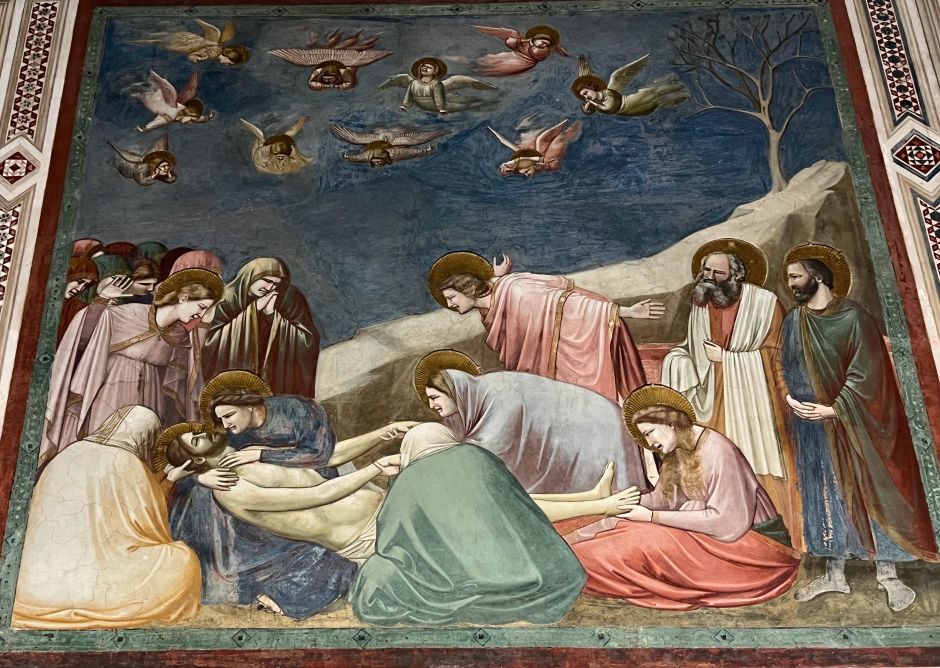
Each group of visitors gets about twenty minutes, so it pays off to do some advance prep. The frescoes show events from the lives of Joachim (the father of Virgin Mary), the Virgin, and Jesus. A Judgment Day takes up the entire western wall. I ended up going three times and the panels that moved me most included Joachim after the rejection of his sacrifice; the meeting between Joachim and Anne at the Golden Gate; Anne’s presentation of her daughter, the Virgin, in the temple; the massacre of the innocents; the birth of Christ; and the lamentation.
The Magic of Frari
The Santa Maria dei Frari is one of those positively overbearing churches that exist mainly in Italy (another example: the Basilica Santa Croce in Florence). Anywhere you step, you stumble into something that would be a peerless treasure in most parts of the world.
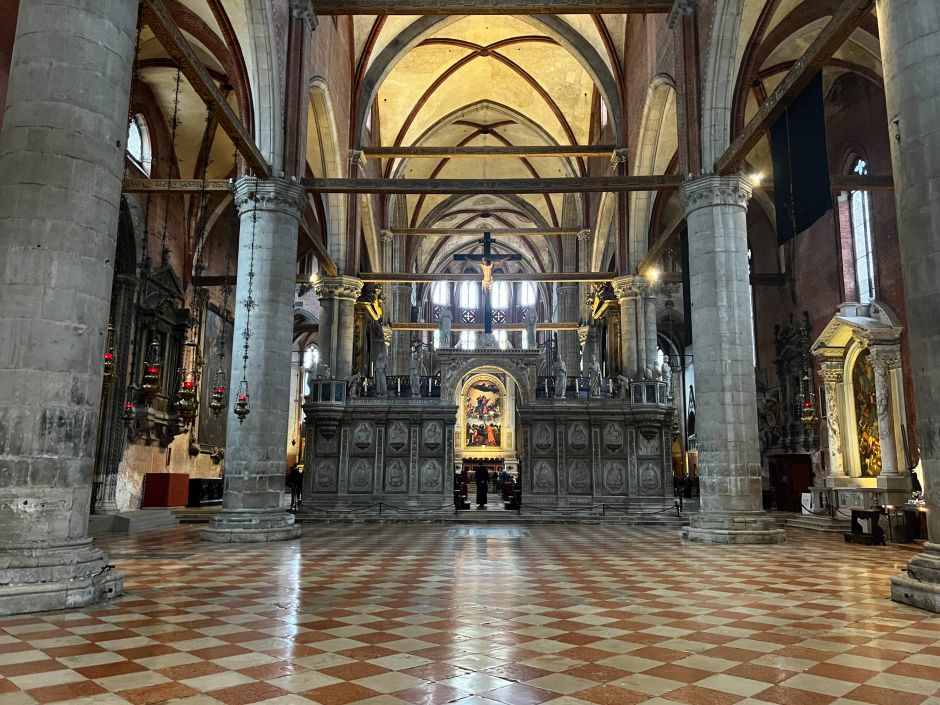
Donatello’s astonishing wooden statue of Saint John the Baptist (1438); Giovanni Bellini’s gorgeous triptych in the sacristy (1488); Titian’s tomb and two of his best works: the Assumption of the Virgin (1515) and Pesaro Madonna (1519); Monteverdi’s tomb; the pyramidal tomb holding the heart of the sculptor Antonio Canova (1827). And the great church itself. Spirit-lifting in the way only medieval churches can be (the Basilica dei Santi Giovanni e Paolo, not far, has a similar scale and vibes).
Tintoretto in Venice
Together with Titian, Tintoretto (1518-1594) was the leading painter of 16th-century Venice. His style was so unusual and idiosyncratic – what came to be known as Mannerism – that people usually love him or hate him without a middle ground. Tintoretto was notoriously prolific. Walk into a church in Venice, and a giant canvas with his characteristically lopsided figures will stare back at you. Lesser works abound, but Venice has the number one Tintoretto pilgrimage site: the Scuola Grande di San Rocco.

A wealthy charitable foundation, the Scuola hired Tintoretto to decorate its fancy new headquarters located across from their own church, the Saint Roch, dedicated to the patron saint of the plague-ridden (whom the Scuola supported). Over a period of twenty-four years (1564-1588), Tintoretto painted nearly sixty vast canvases from the life of Christ and from the Old Testament. They still embellish the Scuola’s walls and ceilings and the effect is completely overwhelming. The Sistine Chapel of Venice.
The Tintoretto repertoire is on full display: oversized figures about to fall off the canvas; an intense use of diagonals and light and shadow; quick brushstrokes and a sketchy, raw appearance; a nervous energy that binds everything together. I’m most partial to these four scenes: Christ before Pilate; Moses drawing water from the rock; the temptation of Christ; and Abraham and Isaac.
The next stop on a Tintoretto tour should be the adjacent church, with four Tintoretto paintings from the life of Saint Roch. Then on to the Gallerie dell'Accademia, also with a few masterpieces.
The Gallerie dell’Accademia in Venice
One of the great old masters museums in Italy, the Gallerie dell’Accademia provides an amazing introduction to Venetian painting, from the Byzantine tryptichs of Lorenzo Veneziano all the way to Giambattista Tiepolo’s light-filled canvases from the twilight years (1750s) of the Venetian Republic.
Already with the early-Renaissance works of the museum, those by Vittore Carpaccio (1465-1525) and Giovanni Bellini (1430-1516), one can discern what’s usually meant by Venetian colors: a shade of pastel pink and pastel blue – less vivid than in Florence and Rome – backed by a metallic sheen. Colors that culminated in Titian and Tintoretto and Paolo Veronese.
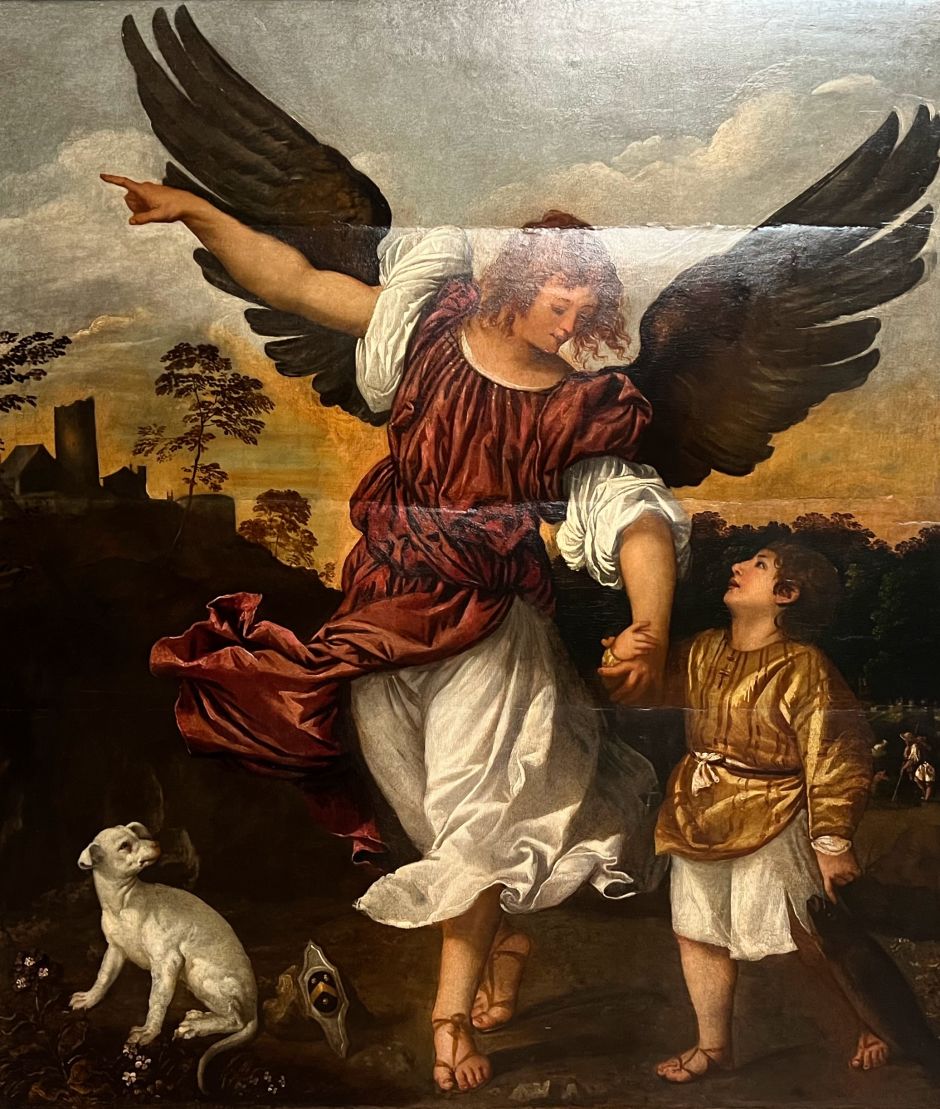
Given my last name, paintings of the story of Tobias and Archangel Raphael always get my attention. The two of them set out to bring back the potion – a mixture of fish scales – that would cure Tobias’s father’s (Tobit) blindness, hence the fish in Tobias’s hand. Titian’s take is an early work (1508), but the captivating orange glow looks familiar from his poetic-violent late period. It shares the hall with one of the most famous paintings in Western art: Giorgione’s Tempest (1502).

Always joyful and superficial, Paolo Veronese brought to us the most exuberant display of Venetian female fashion in the guise of Saint Catherine’s marriage (1565). Tintoretto, his contemporary, was darker and deeper. I kept returning to his Miracle of the Slave (1547), because it’s so ambitious, and to the moving Deposition (1555).
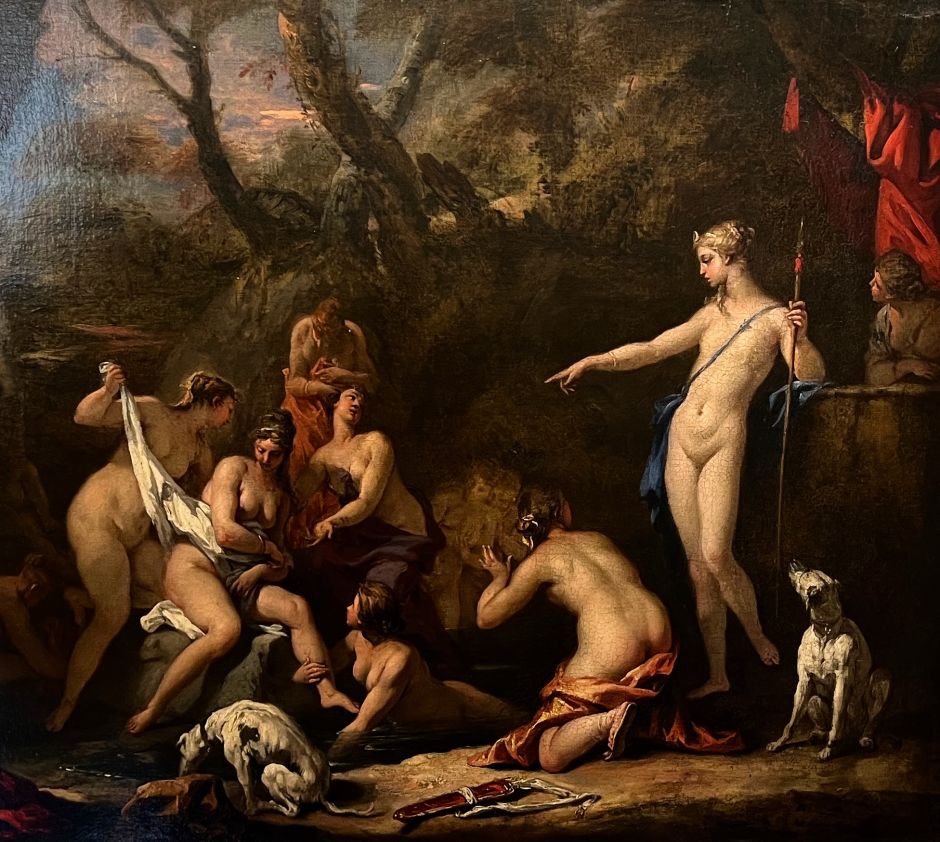
The Baroque period of the Gallerie dell’Accademia is especially strong. The leading figures of 17th-century Italy are all featured, including the Roman giant, Pietro da Cortona, with a canvas of Daniel in the lion’s den (1663). Also here: Bernardo Strozzi, Luca Giordano, Francesco Maffei, Francesco Solimena, and a memorably beautiful Annunciation by Sebastiano Mazzoni. And of course the Venetian stars of the 18th century – more on that below.
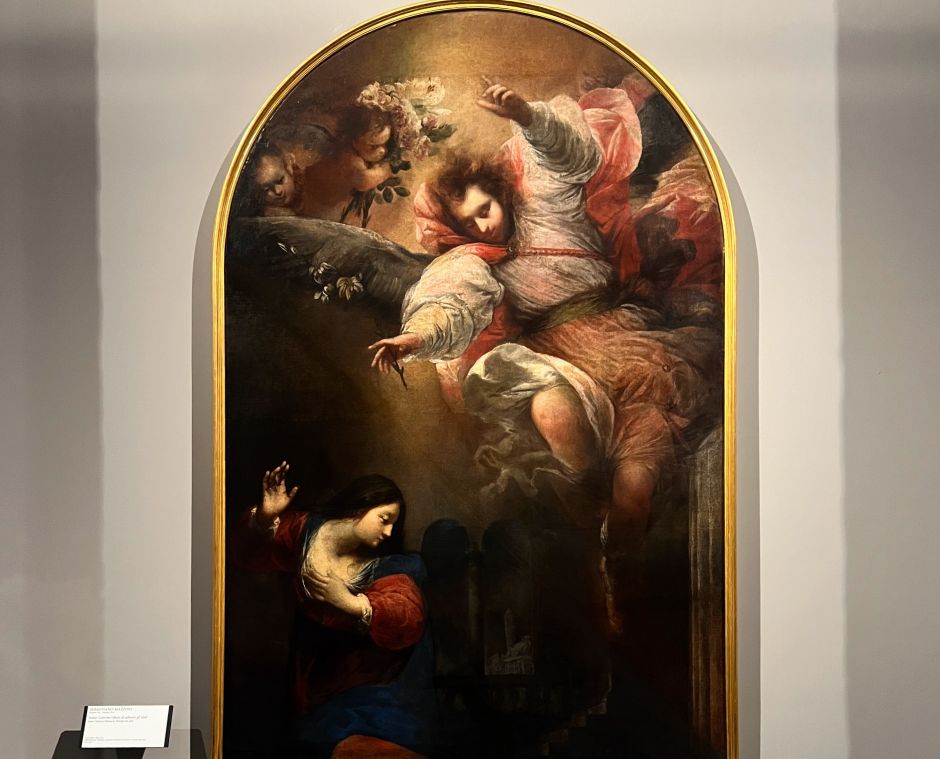
Well curated and never too crowded, the Gallerie dell’Accademia is a wonderful museum, perhaps my favorite in all of Italy.
The Glorious 18th Century of Venice
By the 1700s the Venetian Republic (697-1797) had been long on the decline. Gone were the days when the Most Serene Republic dominated the high seas of Europe. Venice sustained itself on a constant stream of visitors in search of the city’s magical-mystical beauty, grand luxury, and loose morals.
Somehow, a spectacular artistic revival took place in Venice during the first decades of the 18th century. Compared with the dominant painting style of Rome – dark pictures made in the so-called grand manner – Venetians brightened up and uncluttered their canvases. They replaced the clear outlines and plastic forms with rapid and free brushstrokes and a sketchy finish. Their paintings were not unlike the Venice of their time: intense and superficial.
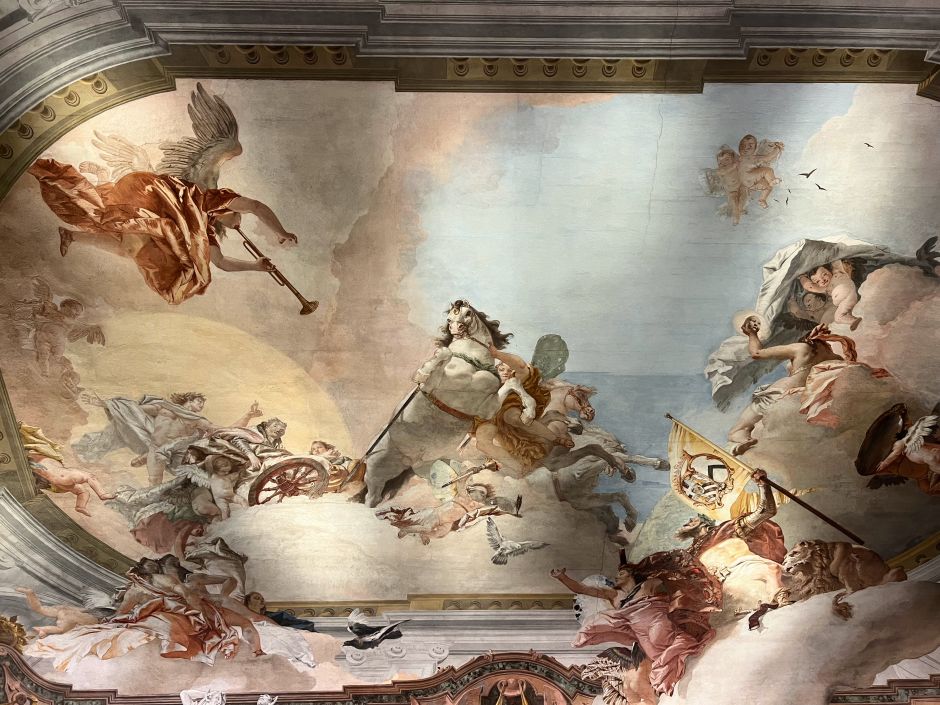
The main figures of this revival were Sebastiano Ricci (1659-1734), Giovanni Battista Piazzetta (1682-1754), and the most famous of all, Giovanni Battista Tiepolo (1696-1770). Others specialized in genre styles that were popular among the middle class. Pietro Longhi painted Rococo-influenced cabinet works of Venetian notables, while Canaletto, Bernardo Bellotto, and Francesco Guardi made topographical views and cityscapes (vedutas) of Venice and other European cities. The greatest collections of 18th-century Venetian paintings are in the Gallerie dell’Accademia, the Ca’ Rezzonico, and the Fondazione Querini.
Three palace-museums in Venice
The Ca’ Rezzonico is a huge classical-Baroque palazzo along the Grand Canal, decked out on three levels with exuberant furniture, frescoes, and paintings from the 18th century. A comically embellished throne on which Pope Pious VII once sat is an example of Baroque excess, but most items are stunning and tasteful, including the bandy legged billiard table.
Giambattista Tiepolo’s bright and sketchy ceiling frescoes and Pietro Longhi’s Rococo genre paintings of the Venetian upper class – including his famous rhino, Miss Clara, the wonder of 1751 Europe – reflect the joyously decadent times in Venice (have to know how to exit in style).

A similar description could be made for the Fondazione Querini, except it’s on the other side of town and its ground floor and garden were magnificently remodeled by Carlo Scarpa in the 1960s (more on Scarpa below). Just steps away is the Palazzo Grimani, which conveys the lifestyle of the most distinguished families of the Venetian Renaissance.
The Grimanis, as was usual, collected classical art, but even your wildest expectations will be exceeded by the so-called Tribuna, a jaw-dropping room loaded with more than a hundred ancient Greek and Roman sculptures under a steeply coffered ceiling from which hangs a stone Ganymede and his abductor. To keep things fresh, the main hall is fitted with big canvases of Georg Baselitz.
Palladio in the Veneto
I really tried. I visited every one of Andrea Palladio's buildings in Vicenza (eleven of them) and went to the Palladio Museum. I saw his churches in Venice, the San Giorgio Maggiore and the Il Redentore. I went to a few of his countryside villas, including the Villa di Maser. Something just doesn't click for me. Perhaps my sequencing was wrong. Palladio (1508-1580) is less impressive when compared with Michelangelo and the Baroque churches of Rome. His buildings appear to be attempts at arriving someplace where ultimately Michelangelo did arrive, not he.
Palladio should be viewed as a progression of the early Renaissance. After Alberti and Bramante. How he brightened up his residential and church facades, made them more textural and sculptural. How he played with light and shadow. How he gave form to the newly emerged villas on the terra firma (the Veneto countryside) when the aristocracy in the mid-16th century turned from sea to land as a source of income. The three-part facade of the Palazzo Chiericati, now home to Vicenza's main picture gallery, and the famous Villa Rotonda, just outside Vicenza, are especially beautiful (any building on that scenic hilltop might look wonderful).
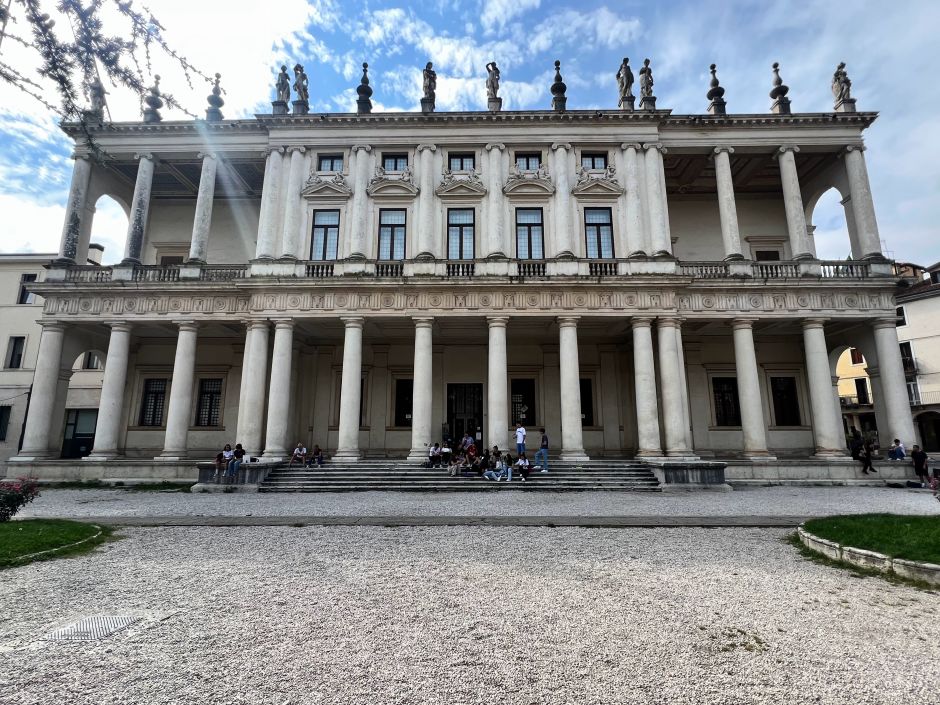
In Venice, Palladio linked the Il Redentore church's rectangular nave to its central dome based on the imperial baths of Rome. Not just structurally: see the thermal windows up top (James S. Ackerman’s excellent little book is assisting me). The church is a good example of the counter-reformationist ideas in practice, as advocated in 1577 by the Milanese Archbishop, Carlo Borromeo. More so than the exuberant church interiors of the 17th-century high-Baroque.

Instead of a wide transept and a bunch of supporting piers breaking up the oneness of the space, here a great vault spans the whole nave which is flanked by arches on piers that open directly into the side chapels. The plain-looking inside feels like a protestant church. There's a complete lack of non-architectural decoration. The walls are painted white. No frescoes, hardly any paintings.
Canova in Possagno
Beside Donatello, Michelangelo, and Bernini, Antonio Canova (1757-1822) is Italy’s best-known sculptor, a Roman god, as it were, of the neoclassical period. He worked for the Bonaparte family during the Napoleonic invasions of Italy, but was similarly active in helping to bring back the countless artworks that Napoleon's troops carted off from Italy.
All his life, Canova was attached to his birthplace, the village of Possagno, about an hour north of Venice and beautifully cradled by the Alps. Even in old age, he dispatched letters to the Venetian Patriarch, lobbying for road constructions to the village (Canova lived in Rome but spent the summers in Possagno). Canova's greatest legacy in Possagno is the enormous hilltop church that he himself designed. It's a near-replica of the Pantheon, parading the famous son of this faraway place (he is buried inside).
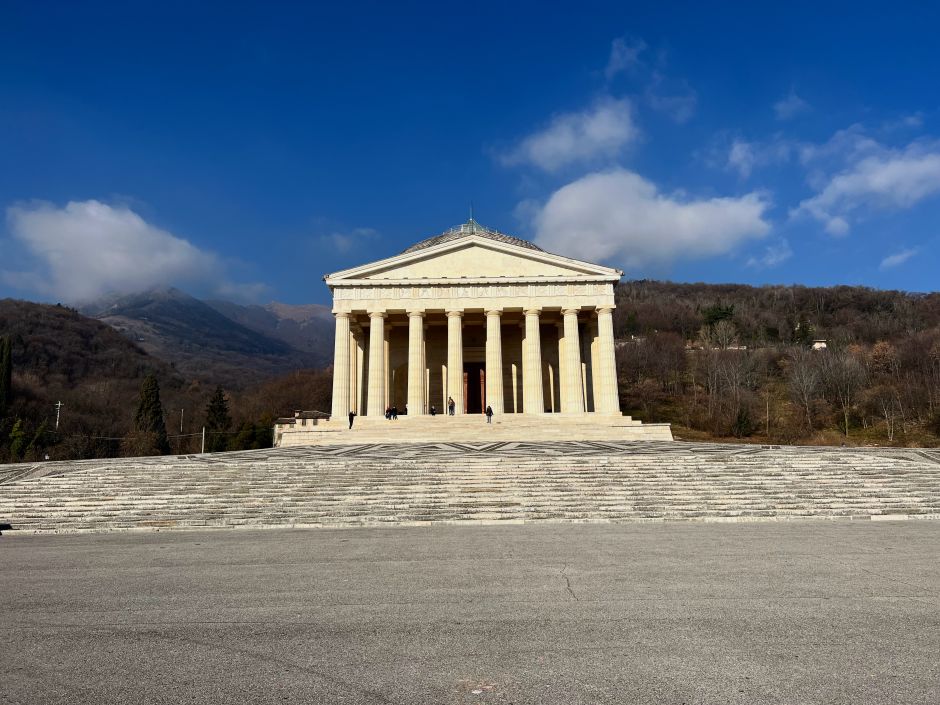
His Possagno house is currently home to the Museo Canova Gypsotheca. With dozens of plaster versions of his famous sculptures, it’s an amazing place for taking in Canova’s entire output. The colossal Hercules and Lichas (original in the National Gallery of Modern Art in Rome), Perseus with the Head of Medusa (Met), Theseus Killing the Centaur (Kunsthistorisches), Napoleon as Mars (Brera and Apsley House), the tomb of Marie Christine (Vienna).
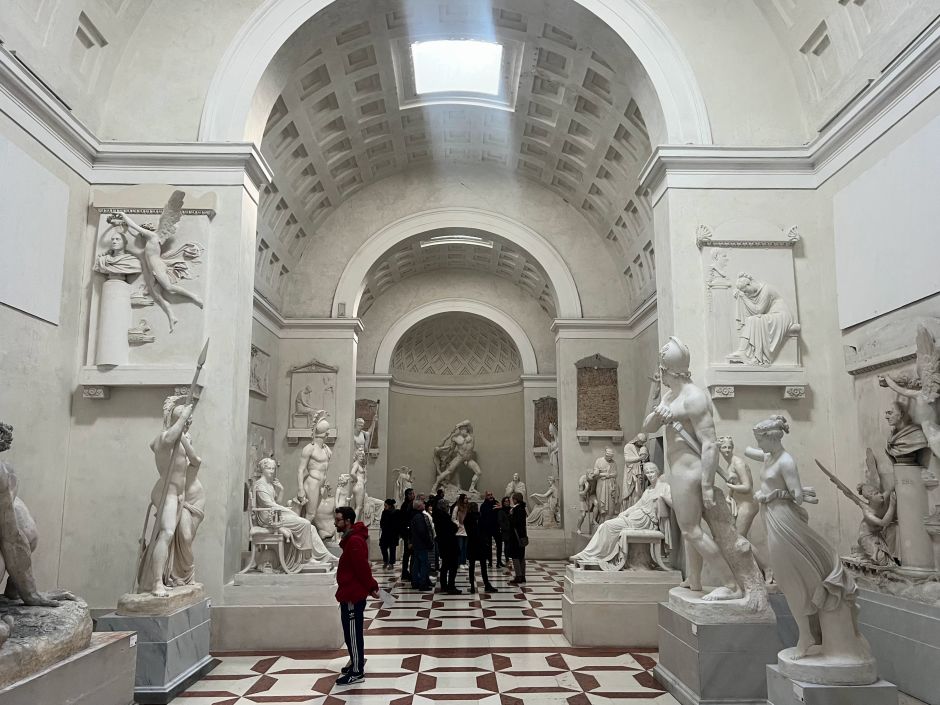
I found myself being drawn to the more expressive pieces. To the bust of the much-tried Pope Pious VII, to the terracotta Maria Magdalene, to the old man attending Marie Christine’s funeral. Canova’s classical figures – like the Greeks, like the Romans – exude a calm and timeless elegance, but I’m instinctively more into art that reflects rather than idealizes the human condition (a very old debate, of course). Pain and suffering; joy and carelessness; the small physical imperfections. Possagno, in any case, is a wonderfully instructive place and also near Palladio’s Villa and Tempietto Barbaro.
Carlo Scarpa in the Veneto
At some point, it was impossible to miss him. His signatures are found across Venice. The latticework patterns, as if a Mondrian painting came to life. The unexpected angles and nooks, similar to Le Corbusier. The sensitive combination of materials – stone, wood, brick, marble, concrete, bronze details – just like Marcel Breuer. The great geometric shapes of Louis Kahn. The Loosian interior elevations: a step up here, a small descent there. He was perhaps the greatest designer of stairs, a notoriously difficult task. Staggered stone slabs of varying sizes that appear to be floating in air. And comfortable to walk on.
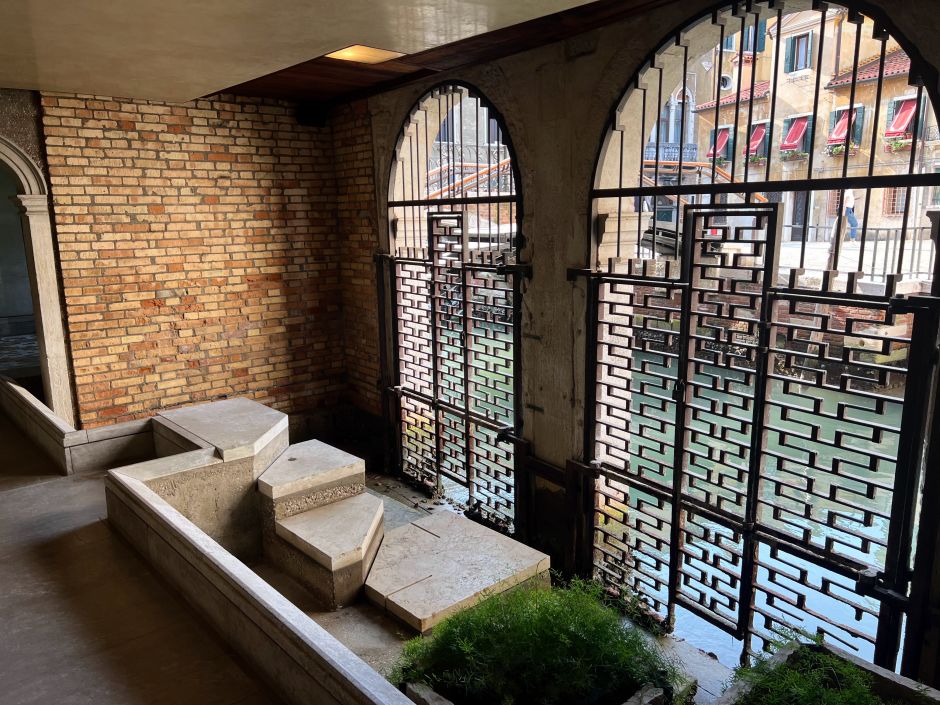
The Venice-born Carlo Scarpa (1906-1978) was one of the great architects of 20th-century Italy and most of his works, mainly remodelings and extensions of historical buildings, are in the Veneto region. In Venice, the Fondazione Querini (with playful water access and a lovely outdoor garden and cafe); the Olivetti showroom (1958) on Piazza San Marco; and the sculpture garden in the Biennale.
Outside of Venice, he designed the Canova Gypsotheca Museum in Possagno (see above), the Brion tombs in Treviso, where he is buried, and the Castelvecchio Museum in Verona. All these places are worth a detour (architecture Michelin: three stars). Scarpa found the middle ground between retaining a sense of place and history, while also leaving an unmistakable mark – his own and of his time.
The François Pinault and the Peggy Guggenheim Collection
The French billionaire businessman François Pinault owns two swanky exhibition venues in Venice for his large collection of contemporary art. The 18th-century Palazzo Grassi and the Punta della Dogana warehouse, both of them remodeled by Tadao Ando and near each other. There’s no permanent exhibition but a rotating set of temporary shows.
The American socialite Peggy Guggenheim (1898-1979) lived in a Grand Canal-facing villa in Venice where she amassed a collection of early modern art that counts among the best in Italy. Prime works by Wassily Kandinsky, René Magritte, Paul Klee, Joan Miró, and Cy Twombly (also the surrealist Max Ernst, who was Guggenheim’s husband in the 1940s).
Part of the reason this museum is worth the steep admission is the access to the premises and to the sculpture garden, sprinkled with Alexander Calders, Henry Moores, and Alberto Giacomettis. Beware that the place is crowded at all times and there is often a long line to enter. If that's the case, remember that you can find international modern art in other cities too – cherish what only Venice can give.